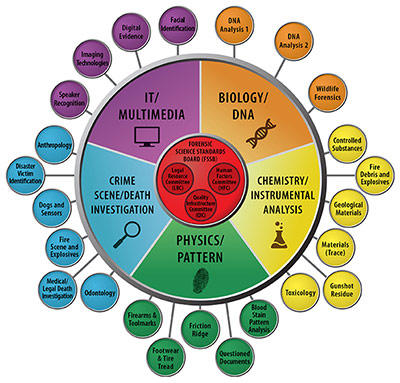
The U.S. Commerce Department's National Institute of Standards and Technology (NIST) announced today the final appointments to the Organization for Scientific Area Committees (OSAC), established to coordinate development of standards and guidelines for the forensic science community. The organization is bringing a uniform structure to what was previously an ad hoc system with the goal of improving the quality and consistency of forensic science in the United States.
"Creating this organization has been a true collaboration with the forensic science community to build the foundations for improving the practice of forensic science," said Acting Under Secretary of Commerce for Standards and Technology and Acting NIST Director Willie May. "We are grateful for the contributions of the many individuals, professional associations and government agencies who have offered their time and expertise."
The 402 experts named today will serve on 23 subcommittees of the five Scientific Area Committees on Biology/DNA, Chemistry/Instrumental Analysis, Crime Scene/Death Investigation, Digital/Multimedia and Physics/Pattern Interpretation. The five Scientific Area Committees reviewed more than 1,400 applications to choose the subcommittee members, with concurrence of the Forensic Science Standards Board, which serves as the OSAC governing board, and the U.S. Department of Justice. Applicants who have not been named as members may be invited to serve as affiliates and will play an important role populating the many task groups to be created by the subcommittees. Task groups will work on specific assignments necessary to develop and assess standards and guidelines.
One subcommittee has yet to have its members named: the addition of the Digital Evidence Subcommittee was announced in September 2014 after the other 23 subcommittees and therefore had a later application period.
Each subcommittee has up to 20 members who normally will serve three-year terms. Members of this initial group will serve two-, three-, or four-year terms, ensuring that in the future, roughly one-third of the members are eligible to be replaced each year. Members are listed by subcommittee on the website. Applications for affiliates and future members will be accepted on a continuous basis through the OSAC website.
The five Scientific Area Committees will hold public meetings on Feb. 16 and 17, 2015, during the annual meeting of the American Academy of Forensic Sciences, in Orlando, Fla.
Background
OSAC is providing a framework for long-term coordination across forensic science disciplines and is part of NIST's commitment to support forensic science through an initiative launched in partnership with the Department of Justice (DOJ) in February 2013. As part of this effort, the DOJ established a new National Commission on Forensic Science in January 2014 to provide policy guidance to the U.S. Attorney General and help set priorities for standards development. NIST's Acting Director May is the commission co-chair along with Deputy Attorney General James M. Cole, and NIST Fellow John Butler serves as a vice-chair with Deputy Assistant Administrator of the Drug Enforcement Agency's Office of Forensic Science Nelson Santos.
As a non-regulatory agency of the U.S. Department of Commerce, NIST promotes U.S. innovation and industrial competitiveness by advancing measurement science, standards and technology in ways that enhance economic security and improve our quality of life. To learn more about NIST, visit www.nist.gov. Learn more about NIST's efforts on forensic science.

